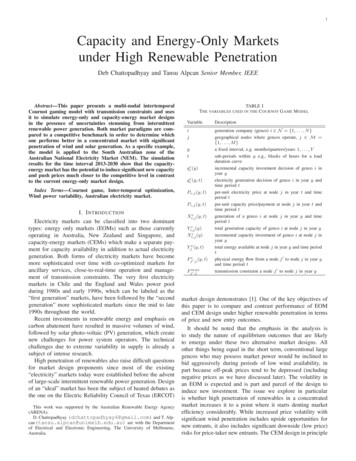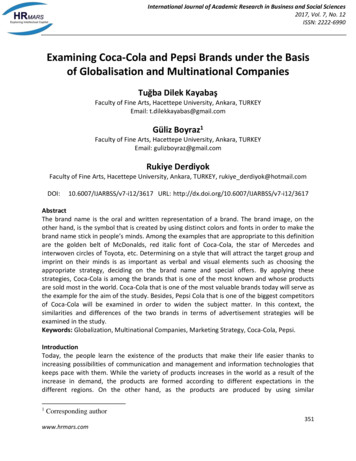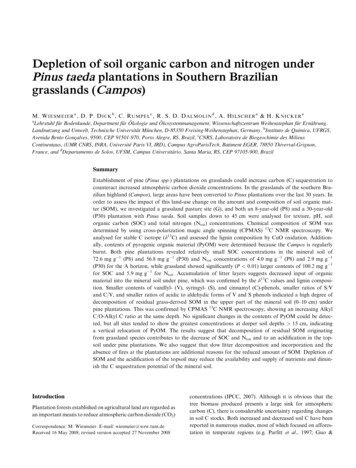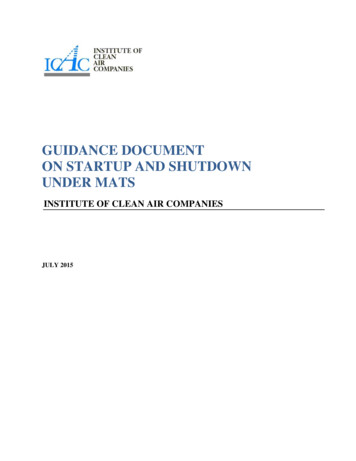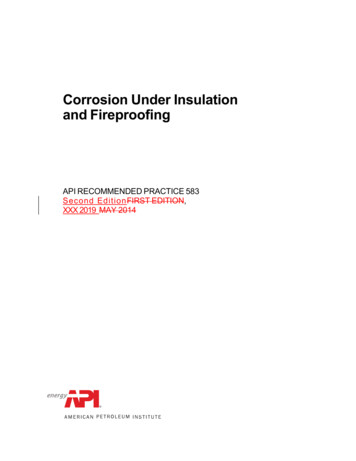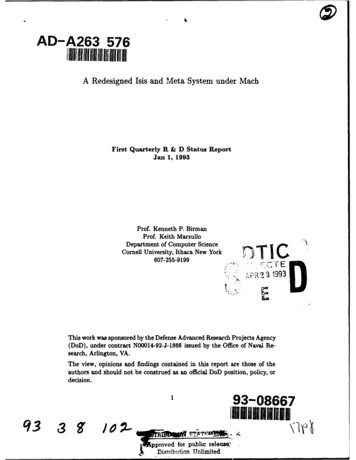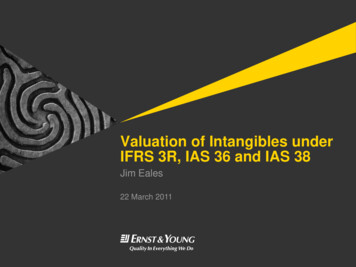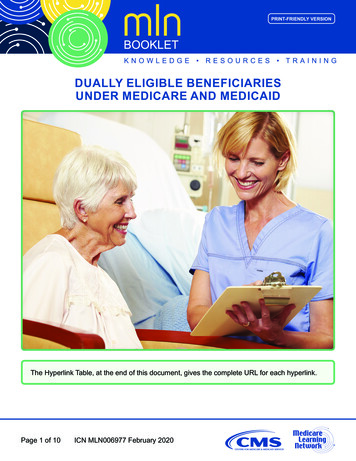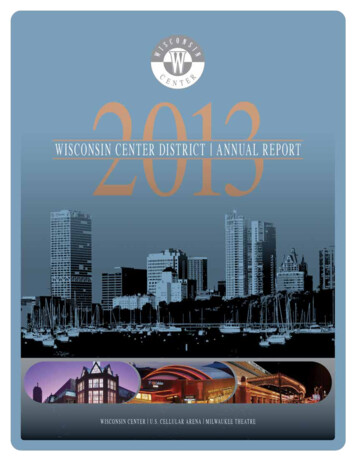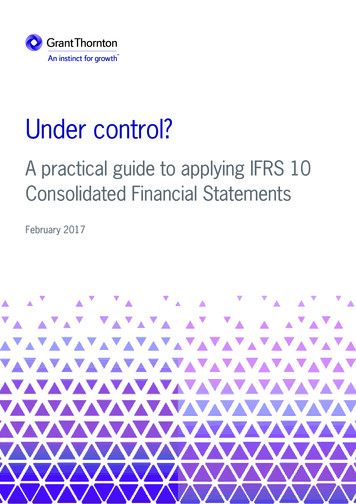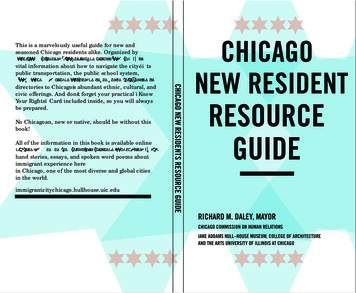
Transcription
No Chicagoan, new or native, should be without thisbook!All of the information in this book is available onlineAT THE SUPPLEMENTAL WEBSITE WHICH ALSO INCLUDES lRSThand stories, essays, and spoken word poems aboutimmigrant experience herein Chicago, one of the most diverse and global citiesin the O NEW RESIDENTS RESOURCE GUIDEThis is a marvelously useful guide for new andseasoned Chicago residents alike. Organized byLOCATION WITH EASY TO READ GRAPHICS YOU WILL lNDvital information about how to navigate the cityói tspublic transportation, the public school system,YOUR LOCAL MUNICIPAL OFlCES AND REPRESENTATIVES ANDdirectories to Chicagoís abundant ethnic, cultural, andcivic offerings. And donít forget your practical ì KnowYour Rightsî Card included inside, so you will alwaysbe prepared.RICHARD M. DALEY, MAYORCHICAGO COMMISSION ON HUMAN RELATIONSJANE ADDAMS HULL–HOUSE MUSEUM, COLLEGE Of ARCHITECTUREAND THE ARTS UNIvERSITY Of ILLINOIS AT CHICAGO
CITY OF CHICAGO NEW RESIDENT'S GUIDEimmigrantcitychicago.hullhouse.uic.edu
CITY OF CHICAGO NEW RESIDENT'S GUIDEimmigrantcitychicago.hullhouse.uic.eduThe Freedom to copy and share the work with others
——Message from MayorRichard M. DaleyDear New Resident:As Mayor and on behalf of the City ofChicago, it gives me great pleasure towelcome you to our city.Chicago’s past and present havebeen shaped by immigrants and refugeeswho came from around the world. Thesedetermined men and women dedicatedthemselves to improving the quality oflife for their families and the communityat large. Your arrival continues thisproud tradition and I have no doubtthat you bring the same energy and optimism to Chicago as did yourpredecessors.Our city government takes pride in its long‑standing tradition ofwelcoming and embracing immigrants and refugees. In keeping with thattradition, the Chicago Commission on Human Relations Advisory Councilon Immigrant and Refugee Affairs has been working diligently to maintainand foster a welcoming climate for our new arrivals. Among many otheractivities, this office conducts education and outreach programs includingthe publication of the Chicago New Residents Resource Guidebook.I commend the partnership between the Advisory Council andthe Jane Addams Hull-House Museum in redesigning, publishing, anddistributing the Guidebook. Such partnership exemplifies public-privatesector collaboration and stands to contribute to the quality and quantityof public service for all citizens.I hope you will find this Guidebook to be a source of useful informationas you build your new life in Chicago. May your new future be filled withhealth, happiness, and prosperity.Best wishes,Richard M. DaleyMayorCity of Chicago——Welcome to ChicagoThe City of Chicago Commission on Human Relations Advisory Councilon Immigrant and Refugee Affairs is pleased to present the 2010–2011edition of the Chicago New Residents Resource Guide. The purpose ofthis publication is to make pertinent information available and contributeto the smooth adjustment of immigrants and refugees to life in Chicago.The Guide comprises many articles and an extensive list of public andprivate resources. The articles provide general information about a widespectrum of topics, including the legal system, housing, health, communityservices, employment, education, and consumer protection. The ResourceListings section provides names and telephone numbers, addresses, andwebsites (where available) of governmental, non-governmental, andcommunity-based service providers that offer services to immigrantsand refugees, either for free or for low fees. Included in the listings areethnic community-based organizations and Consulate General offices.In preparing this edition, special attention was given to designing theGuide to be user-friendly, covering the issues and topics that are mostpertinent, and ensuring that the resource listings are reflective of thediversity of Chicago’s immigrant and refugee community. The end result,we hope, is that the intended beneficiaries of the Guide—immigrantsand refugees, especially newcomers—will find it an informative andempowering tool in their quest for a new and better life in Chicago.Despite our best intention and efforts, we may have omitted certainorganizations from this edition. If your organization was omitted and youfeel that it is appropriate for inclusion in future editions of the Guide,or should you find any inaccuracies in your organization’s listing, pleaseforward us your changes, suggestions, or comments by completing theUpdate Form which is included in the back of the Guide. You may alsocontact us at 312-744-1098 (voice) or 312-744-1088 (TTY).Edwin Silverman, Ph.D., ChairHayelom Ayele, Director/CommunityLiaisonAdvisory Council on Immigrant and Refugee Affairs
——Message from ChairmanDana V. StarksDear Friend in Human Relations:As Chairman and on behalf of the Chicago Commission on HumanRelations (CCHR), it gives me great pleasure to express best wishes to allimmigrants and refugees who have chosen our city as their new home.The CCHR enforces the City’s anti-discrimination laws—The ChicagoHuman Rights and Fair Housing Ordinances (CHRFHO)—and strivesthrough legal and educational means to create a bias-free society. TheCHRFHO prohibit discrimination in the areas of employment, housing,public accommodation, credit, and bonding. It is unlawful to discriminateagainst any person because of his/her race, color, sex, age, religion,disability (including HIV/AIDS positive status), national origin, ancestry,sexual orientation, gender identity, marital status, parental status,military discharge status, or source of income.As mandated by the City’s Hate Crimes Law, the Commission assistshate crime victims. A hate crime is a criminal offense against a personthat is motivated by the victim’s race, color, gender, religion, nationalorigin, age, ancestry, sexual orientation, or disability. Such a crime is afelony (a very serious offense).The CCHR also sponsors programs and activities that reduce biasand promote positive intergroup relations. These programs and activitiesbring people together across racial, ethnic, cultural, and religious linesand promote positive awareness of diversity. This Guide is intendedto contribute toward that end; and it is our hope that immigrants andrefugees (especially recent arrivals), social service providers, and otherswill find it useful and informative.We look forward to being of service to you as you establish a newlife in our city.Dana V. StarksChairman and CommissionerChicago Commission on Human Relations——AcknowledgmentsThe successful completion of this project would not have been possiblewithout the guidance and support of the members of the ChicagoCommission on Human Relations Advisory Council on Immigrant & RefugeeAffairs. In particular, Council Chair Edwin Silverman and the Education andOutreach Committee members Hussein Affey and Bindi Desai-Lessingdeserve our heartfelt thanks for their contribution to the Guide.Thanks also to First Deputy Commissioner Kenneth Gunn for hisguidance and support for this project. Iris Archilla, Joanne Newsome andWilliam Greaves of the Chicago Commission on Human Relations have beenof great assistance in reviewing and critiquing the first draft of the Guide.Special thanks to Makeysha Durham-Diouf, Uraidah Hassani, andJames Muhammad, who gave immeasurable amounts of volunteer timeand expertise. Their dedicated efforts have ensured a comprehensive listof resources and up-to-date information.And finally, thanks to our partner agency, the Jane Addams HullHouse Museum at the University of Illinois at Chicago, and its fine staff,without whose generous financial support and expertise the successfulcompletion of this project would not have been possible.
——Message from Jane AddamsHull-House MuseumThe Jane Addams Hull-House Museum is a proud partner of this resourceguide and the accompanying website, www.abcdefg.org, which is filledwith personal stories, essays, poetry and first-person accounts of whatit means to immigrate, migrate and to take refuge in Chicago, one of themost diverse and cosmopolitan cities of the world.We encourage you to use this guide to partake of everything Chicagohas to offer. And in the spirit of Hull-House’s commitment to the democracy,diversity and inclusivity that animate this book, we also acknowledge thatnew immigrants profoundly contribute in an inestimable way to the lifeof our dynamic city.Each chapter of this book provides critical information for any newresident to the city. Not only will you find information about how to obtainaffordable housing, locate hospitals for health care, navigate the ChicagoTransit Authority, and learn how to register your kids for public schools,but you will also discover a Know Your Rights Card from the AmericanCivil Liberties Union, find information specific to immigrant’s rights fromthe National Center for Immigrant Justice, learn how to get a library cardso you can check out a free book at a local Chicago Public Library, locatethe closest fresh green market for local vegetables, and find listings forethnic museums and cultural organizations. This book will make it easierfor you to participate in the artistic and cultural aspects of urban life andbecome civically engaged.The Jane Addams Hull-House Museum expresses its solidarity withimmigrants to this city by co-funding/co-publishing? this resource guideand its accompanying website. We invite you to visit the Museum, whichis a national historic landmark, located at 800 South Halsted Street intwo of the original Hull-House Settlement buildings. We celebrate andinterpret the history of Jane Addams, America’s first woman to winthe Nobel Peace Prize, and the work of the reformers and communitymembers who participated in the programs and activities of the Hull-House Settlement that transformed the United States into a more sociallyjust and democratic country in the early 1900’s.The Hull-House Settlement was situated at Halsted and Polk Streets,and much of its success as a boldly visionary public space, a laboratoryfor democracy and engine for social change, is due to the fact that thecommunities surrounding Hull-House were populated with the mostrecent immigrants to the United States. Over two-dozen ethnic groupslived near the Hull-House and community members attended readingclubs, language classes, citizenship classes, sex-education classes,poetry readings, music performances, as well as ethnic theater. HullHouse modeled a new kind of citizenship and patriotism.Jane Addams and her group of Hull-House reformers opposedimmigration restriction and the quota system, and they also opposedAmericanization programs that attempted to wipe away culturaltraditions of immigrants. They cared deeply about the welfare of newimmigrants and of all people. The fight for immigrants’ rights includedadvocating for fair labor practices, public housing and health regulations,educational reform and justice reform that benefited all of us. This bookand the accompanying website champion the idea that immigration is nota challenge to our democracy, as it is sometimes portrayed, or a problemthat needs to be addressed, rather immigration can and should realizethe ideals of democracy- equality, diversity, and inclusivity.This book would not have been possible without the tireless work ofMargot Nikitas, who became a passionate immigration activist and projectcoordinator at the Museum, the team of designers who contributed to thedemocratic design of the book including Benjamin Thorp, Sarah Higgins,under the leadership of Jonathan Krohn, and the visionary Marcia Lausen.We also thank the Boeing Corporation for their support that made thisresource book and the website possible, and their commitment topromoting civic life in Chicago.Lisa Yun LeeDirector, Jane Addams Hull-House Museum
table of contents17Becoming a U.S. Citizen6923Consumer ProtectionBecoming an Educated Consumer31Know Your GovernmentElected Officials The City of ChicagoAnti-Discrimination LawsEthnic OrganizationsAsian Community-Based Organizations African CommunityBased European Community-Based organizationsLatino Community-Based organizations Middle EasternCommunity-Based OrganizationsBenefits of Citizenship Citizen Requirements Applyingfor Citizenship91ListingsHospitals Museums & Cultural Institutions FarmersMarkets/Food Co-ops Consulates39Community ServicesOrganizations by Regions45Chicago101 CentralImportant Symbols Geography Physical LayoutClimate Hot Weather Tips Cold Weather Tips155 North49Health Services193 Northwest53Education205 South57Housing233 Southwest61Employment243 Suburbs/Other65Chicago Neighborhood Map255 West67CTA MAP
Becoming aU.S. CitizenAcquiring U.S. citizenship is the ultimate goal of everyone who has chosenthe United States of America as her or his new country. The process ofbecoming a U.S. citizen is called “naturalization.”——benefits of citizenshipThe Right to VoteCitizenship gives you the right to vote in local, state, and national elections.Voting allows you to choose your representatives in government. Youmust register to vote at least one month before any election. Voterregistration forms are available at your swearing-in ceremony or at anypost office or library.Greater Freedom to Travel and Sponsor a RelativeWhen you become a citizen, you accept all of the responsibilities of beingan American. In return, you get the rights and privileges of citizenship.——citizenship requirementsIn order to become a U.S. citizen, you must meet certain requirements.You must:— Be at least 18-years-old;— Have lived in the U.S. as a legal permanent resident for at least fiveyears, or three years if permanent residency was obtained throughmarriage to a U.S. citizen;— Be of good moral character. For example, you must have paid yourtaxes on time and not have been convicted of a serious crime. If anycriminal record exists, please consult a lawyer or local communityorganization before filing your citizenship application;— Males between the ages of 18 and 26-years-old must register for theSelective Service System. (To check if you have registered or to get yourSelective Service registration number, call 1-847-688-6888);— Demonstrate that you have knowledge and understanding of U.S.history and civics. Visit or call your local community organization formore information about the standardized naturalization exam. Free orlow-cost citizenship classes and citizenship applications are availablethrough organizations listed in this Guidebook.As a citizen, you will be able to leave the U.S. anytime and for as long asyou like and then return without restrictions. To travel outside the U.S.,you must obtain a passport. You can also apply to bring close relativessuch as your spouse, children, parents, brothers, and sisters to theUnited States as legal permanent residents.To become a citizen, you must be willing to swear your loyalty to theUnited States. You must agree to support and defend the U.S. Constitution.CIT Y OF CHICAGO NEW RESIDENTS GUIDE17CIT Y OF CHICAGO NEW RESIDENTS GUIDE18
——applying for citizenshipStep One: Fill Out N-400 ApplicationFill out an N-400 application from the U.S. Citizenship and ImmigrationServices (USCIS). You can receive the form in one of the following ways:— Visit a local Community Organization;— Call USCIS Forms Request Line at 1-800-870-3676 (in English andSpanish);— Visit a local Chicago Public Library;— Log on to the USCIS Website, www.uscis.govOnce the form is completed, send it to the USCIS (see Form N-400 formailing address) along with:— A copy of your Alien Registration Card (Green Card);— Applicable fees in the amount as specified in the N-400 instructionsheet;— Photographs as specified in the N-400 application.Step Two: Have Fingerprints TakenAfter you send the completed packet to the USCIS, you will receivean appointment notice for your fingerprints to be taken digitally at anApplication Support Center. You must bring the notice to the USCISfingerprint facility, along with a valid identification card. Once yourfingerprints are taken, USCIS submits them to the Federal Bureau ofInvestigation (FBI) for processing.CIT Y OF CHICAGO NEW RESIDENTS GUIDE19Step Three: Waiting Period/Study U.S. History and Civics and Prepare foran InterviewThere is a considerable waiting period before the USCIS can scheduleyou for an interview. It is important that you use this period to studyU.S. history and civics in preparation for your interview. A communityorganization can refer you to a free or low-cost Citizenship class in yourarea. For more information, contact your community organization orsee the citizenship & ESL service column under “Type of Service” in the“Quick Reference to Service Providers” section of this Guidebook.The USCIS officer will ask you questions about U.S. history andgovernment from the list of U.S. history and civics questions. You willthen be asked to demonstrate a basic knowledge of English by writing afew short sentences dictated by the examining USCIS officer. This reviewalso allows the examiner to see if you can speak and understand basicEnglish. When you come for your interview, you will need to provideapplicable documents such as a certificate of marriage, divorce, or deathof a spouse; dates of any travel in and out of the U.S.; and your incometax returns.Exceptions to the English Language RequirementDepending on your age and length of residency, you may be exempt fromthe English language requirement. This means that you can take the civicsexamination in your native language if you are 50-years-old with at least20 years as a legal permanent resident, or if you are 55-years-old with15 years as a legal permanent resident. In these cases, you may have aninterpreter present during your interview. If you are at least 65-yearsold and have been a U.S. resident for 20 years, you will be given specialconsideration in the degree of difficulty of the questions asked.CIT Y OF CHICAGO NEW RESIDENTS GUIDE20
In some cases, applicants with certain disabilities such as blindnessor deafness may qualify for disability waivers to the English languagerequirement. Please consult a lawyer or local community organization formore information and a copy of the USCIS Disability Regulations.Step Four: Taking the Oath of AllegianceWhen you pass your USCIS interview and the U.S. history and civicsrequirement, your path to citizenship is nearly complete. The final stepis to take the Oath of Allegiance at an USCIS administrative ceremony orat a ceremony with a judge. After taking the oath, you will receive yourCertificate of Naturalization as evidence of your U.S. Citizenship.Note: If you move, you are required by law to notify the USCIS of thechange of your address. A “Change of Address” form is available at theChicago USCIS District Office (101 W. Congress Parkway) or the USCISwebsite (www.uscis.gov). Be sure to include your name, new address,your Alien number (file number), and notification that you have a pendingcitizenship application, if any. For more information, please contact USCISCustomer Service Center at 1-800-375-5283CIT Y OF CHICAGO NEW RESIDENTS GUIDE21CIT Y OF CHICAGO NEW RESIDENTS GUIDE22
ConsumerProtectionThe City of Chicago Department of Business Affairs and ConsumerProtection (DBACP) is a special department that helps consumers througheducational and enforcement programs. In addition to conducting manyprograms, the DBACP provides reliable information and referral services.Special programs and educational materials are developed to helpconsumers understand their rights and teach them to file complaints.Additionally, the DBACP investigates complaints against businesses andverifies that businesses have all required licenses needed for operationin the city. The DBACP can be reached by calling 1-312-744-9400 (voice)or 1-312-744-9385 (TTY).Becoming an EducatedCon
Listings section provides names and telephone numbers, addresses, and websites (where available) of governmental, non‑governmental, and community‑based service providers that offer services to immigrants and refugees, either for free or fo

